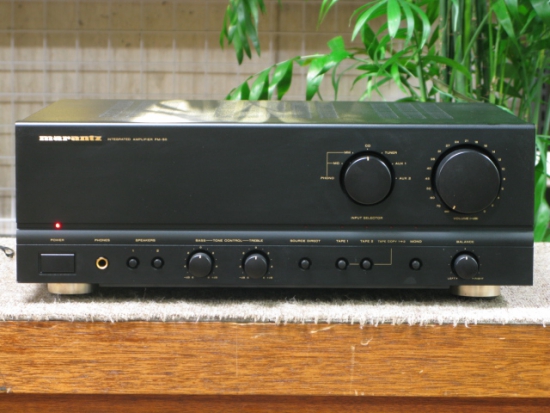Marantz PM-50 Amplifier
Marantz has long adopted a policy of continuous development, rather than changing a product each year simply for the sake of it.
Consequently the arrival of this PM-50 middle-market amplifier is something of an event, this model effectively replacing the stalwart PM-45.
The design has minimalist pretentions, but is still equipped to handle four line inputs, two tape decks and both MM and MC vinyl disc sources. The style is smoother and more refined than previous units, the upper half of the matt black alloy fascia accommodating a rotary input selector and large volume control. The lower section has balance, bass and treble rotary controls plus pushbuttons for A/B speaker selection, mono operation, tape monitoring and 'source direct'.
Source direct in fact bypasses the main selector, tone and balance circuitry by means of an encapsulated Anritsu relay, feeding line-level signals directly from the volume control to the integral power amp. The internal design is similar to earlier Marantz amplifiers, featuring a low impedance power supply, symmetrical power amp construction and a discrete phono headamp based around low-noise FETs. Once again Marantz has opted for an STK supply/driver hybrid, while the complementary output transistors are the same as those used in the PM-65AV AV amplifier.
LAB REPORT
The supply regulation is very tight, as evidenced by the healthy 2.3dB power increase from 8 to 4 ohms and high 21A peak current, alongside lowish (+ 1dB) IHF dynamic headroom. The Marantz PM-50 should be very load-tolerant as a result. Stereo separation, channel balance and noise are all exceptionally good, particularly via the CD and MM vinyl disc inputs. However the disc input positive phase shifts measured at 20Hz are quite high and probably relate to the abrupt LF roll-off of the RIAA eq. stage.
SOUND QUALITY
According to our listening test results, the lean and transparent sound of earlier middle-market Marantz amplifiers has given way to a warmer and less distinct approach. The PM-50 began many tracks with a pleasantly open and smooth balance, only to become slightly more confused and hazy once more instruments had joined the fray.
This was a pity, for the PM-50 had many strong points, notably a bass which dug deep, revealing a tactile and earthy ruggedness. Percussive sounds were equally smooth, sweet and tonally pure, if lacking a little in surrounding space or 'air'.
In fact the bass performance of this amplifier could be positively frightening - a little embellished perhaps but certainly very full and rich, giving the impression of awesome power and authority. This rich and meaty sound was similarly evident when listening via the MM vinyl disc input, counterpointed by a fast, sharp and articulate treble. Vocals were equally powerful, but for all its lungfuls of conviction, a little more subtlety would have not gone amiss. This amp goes for the jugular, make no mistake.
CONCLUSIONS
In terms of measured and subjective performance, the PM-50 amounts to a very impressive amplifier. Yet its marvellously full and detailed sound was concentrated into too small a soundstage. If only the amplifier could develop more space to 'breathe', then it would undoubtedly sing better too. Beware of quick and superficially stirring demonstrations, since the PM-50 is less certain to guarantee long-term satisfaction. Still, if brawn counts for more than finesse in your priority, the Marantz PM-50 will be well worth a look.




